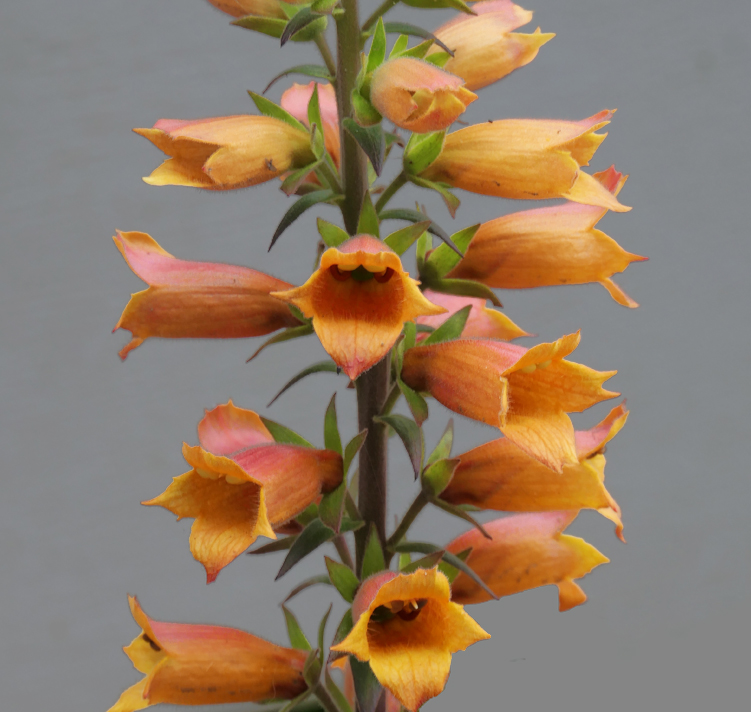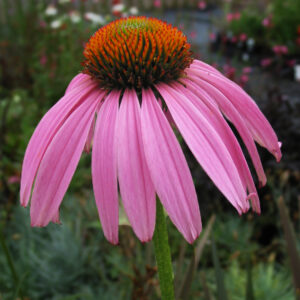- 1-9 pkts $4.50
- 10 pkts FREE
- Express post $12
Isoplexis isabelliana
CANARY ISLAND FOXGLOVE
Isoplexis isabelliana is aristocratic enough to make you curtsy.
And such a prolific bloomer it is hard to take your eyes off the flower spires for months on end.
So with the most “on-style” apricot-sherbet colouring, combined bone-hardiness, the Canary island Foxglove is a must have in contemporary garden design.
Glorious colours of sunset
Isoplexis isabelliana has packed spires of flowers in stunning sunset shades of rich coppery-apricot, with blushes of deep rust.
The overall effect is of rich colour, but without being brashly orange.
And the spires simply glow amongst blue, purple or white flowers.
Each noble flower spire is densely packed with slender, pointed petal, elegant trumpets. With none of the blowsy coarseness of some of the Foxglove cousins.
Even the stems tone in with deep rust-red colouring, against fresh, deep green leaves.
Continuous & abundant blooming for months
Isoplexis isabelliana is the best value going for length of blooming season – from late spring to autumn’s end.
As well as for abundance of blooms.
Because each plant continuously produces numerous spires of flowers.
Drought hardy & very water-wise
As a native of the Canary Islands, Isoplexis isabelliana is naturally adapted to long summers with heat and dry.
It can bloom and thrive on a minimum of additional summer water.
And is highly rated as a drought resistant plant.
It simply revels in sun, though it can also tolerate some shade for part of the day.
Well drained soil is important
And Canary Island Foxglove purrs happily in lime based soils or with the regular addition of some lime to more acid soils.
So it grows happily where roses grow. Which is a blessing because they look sensational together.
(Picture it towering up among apricot, cream, white, or deep red roses – delicious).
It is also blissfully happy in sandy or gravelly soils, and at home by the seaside.
The stout stems are strongly self supporting in all but the very windiest of sites.
Best grown on the lean side
Do not overfertilize your Isoplexis isabelliana for best flowering and strong, upright growth.
Too much feed or rich soil will promote more leafy growth, whereas on a leaner diet they will flower their heads off for months.
Tolerant of mild frost down to approx. -5°C.
Magnet for bees, birds & butterflies for months
The slender, elegant trumpets of Isoplexis isabelliana are like magnets to our native honey-eating birds. Who will perform somersaults to make sure they do not miss a single flower.
While the bees are besotted for months, and the butterflies grateful for such a sure supply of nectar.
So Canary Island Foxglove is one of the very best resources of bee food because of it’s incredibly long and constant blooming.
Resistant to deer & rabbits
Isoplexis isabelliana is highly resistant to deer and rabbits.
Because our nibbling foes seem to know that Isoplexis are cousins to Foxgloves and so should be left uneaten.
Isoplexis are also immune to just about every other pest, disease or deprivation.
And are rarely put off their flowering stride by anything.
In fact there is much breeding work currently being done to produce hybrids between Foxgloves and Isoplexis to inject this fierce hardiness and length of blooming.
Hardy evergreen, shrubby perennial
Isoplexis isabelliana is a hardy, shrubby, evergreen perennial clump.
Growing to 1.2m. High in elegant spires of flowers x 40cm. Wide clump of attractive, deep green refined foliage.
Though it is such a prolific bloomer – be prepared to make fresh plants from seed after about 3-5 years. But it is a glorious few years it gives.
Named for one of the most noble, famous and fierce queens of Spain – Isabella of Castille (1451-1504).
SEED SOWING ADVICE: QUICK & EASY
Perfect for beginners & gardening with kids
Scatter seed directly in the garden during spring or autumn / or sow indoors at any time.
INDOORS: First sow the seed in a punnet on surface of good quality seed raising mix.
Make sure the mix is quite sandy and free draining.
You can add a little extra clean sand if needed.
Then gently press the seeds onto the surface of the mix, to ensure good contact.
But do not cover the seed because these seeds need light to germinate.
Then place the sown punnet into a shallow water bath so the moisture percolates up through the mix from the bottom to the surface.
Soak for a short time until moisture appears on the surface of the mix, and then remove and drain.
Because the mix needs to be moist throughout, but not wet.
Now place the moist punnet in a warm, well-lit position (not in any direct sun).
Temperatures of 20-23°C approx. are best for rapid and optimum germination.
And you can use a temperature-controlled heat mat if you have one to encourage rapid germination, but it is not essential. A window-sill or well-lit corner is also fine.
Adding a clear plastic cover or plastic bag helps to retain moisture in the punnet.
And continue to keep the punnet moist by spraying the surface of the mix with a fine spray water bottle as required.
Seedlings emerge in approx. 21-30 days.
SEED COUNT: 5 seeds per pack approx. (Seed of this lovely aristocrat is scarce).
Click here for Nursery Open Days & Open Gardens Information
https://www.gardivalia.com.au/open-gardens
Click here to go back to Seeds Shop
https://www.seedscape.net.au/shop/
Related products
-
Add to WishlistAlready In WishlistAdd to Wishlist
-
Add to WishlistAlready In WishlistAdd to Wishlist
-
Add to WishlistAlready In WishlistAdd to Wishlist
-
Add to WishlistAlready In WishlistAdd to Wishlist





